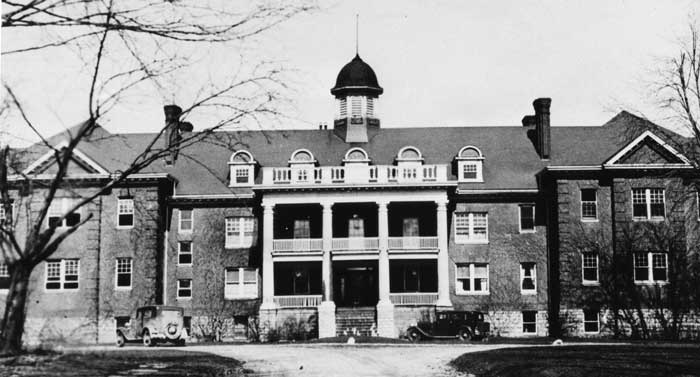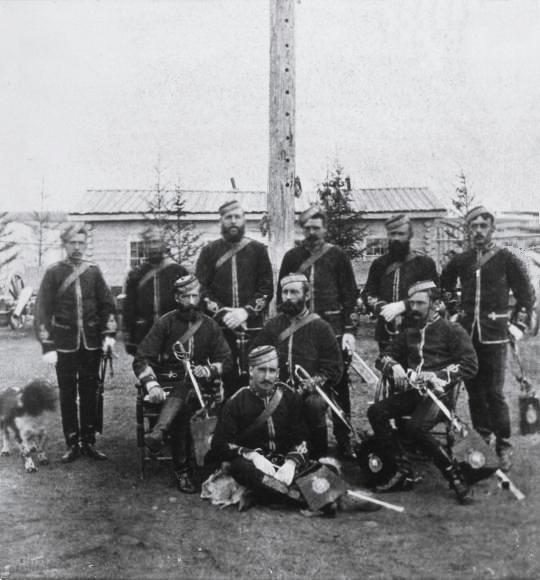|
Pass System (Canadian History)
The pass system was a system of Internal passport, internal passports for Indigenous peoples in Canada, Indigenous Canadians between 1885 and 1941. It was administered by the Indigenous and Northern Affairs Canada, Department of Indian Affairs (DIA), beginning after the 1885 North-West Rebellion as part of a broader effort to confine indigenous people to Indian reserves, then newly formed through the Numbered Treaties. The system, initially intended as a temporary measure to quell disorder in the prairie provinces, eventually became a permanent feature of federal Indian affairs policy. Parliament of Canada, Parliament never sanctioned the pass system; it was an administrative policy of the Department of Indian Affairs. The system remained in place until 1941; its purpose was to limit the freedom of movement of indigenous populations. Federal officials asserted that "Indians had to be kept separate from the rest of society for their own good, as contact tended to be injurious to ... [...More Info...] [...Related Items...] OR: [Wikipedia] [Google] [Baidu] |
Internal Passport
An internal or domestic passport is a type of identity document issued in a passport-like booklet format. Internal passports may have a variety of uses including: # An ordinary identity document produced in a passport format (such as the modern Russian internal passport) # Recording the residence and place of employment of citizens for civil registration purposes (such as the Chinese hukou) # Management and restriction of internal migration (as in the Soviet Union) # Recording demographic information such as ethnicity and citizenship and immigration status, sometimes related to structural discrimination (such as the pass books in Apartheid South Africa) # Controlling access to closed cities and other sensitive locations When passports first emerged, there was no clear distinction between internal and international ones. Later, some countries developed sophisticated systems of passports for various purposes and various groups of population. Summary Countries that currently ... [...More Info...] [...Related Items...] OR: [Wikipedia] [Google] [Baidu] |
Manitoba
Manitoba is a Provinces and territories of Canada, province of Canada at the Centre of Canada, longitudinal centre of the country. It is Canada's Population of Canada by province and territory, fifth-most populous province, with a population of 1,342,153 as of 2021. Manitoba has a widely varied landscape, from arctic tundra and the Hudson Bay coastline in the Northern Region, Manitoba, north to dense Boreal forest of Canada, boreal forest, large freshwater List of lakes of Manitoba, lakes, and prairie grassland in the central and Southern Manitoba, southern regions. Indigenous peoples in Canada, Indigenous peoples have inhabited what is now Manitoba for thousands of years. In the early 17th century, English and French North American fur trade, fur traders began arriving in the area and establishing settlements. The Kingdom of England secured control of the region in 1673 and created a territory named Rupert's Land, which was placed under the administration of the Hudson's Bay ... [...More Info...] [...Related Items...] OR: [Wikipedia] [Google] [Baidu] |
Canadian Indian Residential School System
The Canadian Indian residential school system was a network of boarding schools for Indigenous peoples. The network was funded by the Canadian government's Department of Indian Affairs and administered by various Christian churches. The school system was created to isolate Indigenous children from the influence of their own culture and religion in order to assimilate them into the dominant Euro-Canadian culture. The system began with laws before Confederation and was mainly active after the Indian Act was passed in 1876. Attendance at these schools became compulsory in 1894, and many schools were located far from Indigenous communities to limit family contact. By the 1930s, about 30 percent of Indigenous children were attending residential schools. The last federally-funded residential school closed in 1997, with schools operating across most provinces and territories. Over the course of the system's more than 160-year history, around 150,000 children were placed in reside ... [...More Info...] [...Related Items...] OR: [Wikipedia] [Google] [Baidu] |
Truth And Reconciliation Commission Of Canada
The Truth and Reconciliation Commission of Canada (TRC; []) was a truth and reconciliation commission active in Canada from 2008 to 2015, organized by the parties of the Indian Residential Schools Settlement Agreement. The commission was officially established on June 1, 2008, with the purpose of documenting the history and lasting impacts of the Canadian Indian residential school system on Indigenous students and their families. It provided residential school survivors an opportunity to share their experiences during public and private meetings held across the country. The TRC emphasizes that it has a priority of displaying the impacts of the residential schools to the Canadians who have been kept in the dark from these matters. In June 2015, the TRC released an executive summary of its findings along with 94 "calls to action" regarding reconciliation between Canadians and Indigenous Peoples. The commission officially concluded in December 2015 with the publication of a multi ... [...More Info...] [...Related Items...] OR: [Wikipedia] [Google] [Baidu] |
North-West Mounted Police
The North-West Mounted Police (NWMP) was a Canadian paramilitary police force, established in 1873, to maintain order in the new Canadian North-West Territories (NWT) following the 1870 transfer of Rupert's Land and North-Western Territory to Canada from the Hudson's Bay Company, the Red River Rebellion and in response to lawlessness, demonstrated by the subsequent Cypress Hills Massacre and fears of United States military intervention. The NWMP combined military, police and judicial functions along similar lines to the Royal Irish Constabulary. A small, mobile police force was chosen to reduce potential for tensions with the United States and First Nations in Canada, First Nations. The NWMP uniforms included red coats deliberately reminiscent of British and Canadian military uniforms. The NWMP was established by the Canadian government during the ministry of Prime Minister of Canada, Prime Minister Sir John A. Macdonald, John Macdonald who defined its purpose as "the preserva ... [...More Info...] [...Related Items...] OR: [Wikipedia] [Google] [Baidu] |
Indian Agent (Canada)
From 1755 to 1830 Indian agent was a representative of the British Indian Department in British North America. From the 1830s (beginning in what was then so-called "Lower Canada") until the 1960s, an Indian agent was the Canadian government's representative on First Nations reserves. The British involvement ended in 1860 when Indigenous affairs were whole Canadian responsibility. The role of the Indian agent in Canadian history has never been fully documented, and today the position no longer exists. The position of Indian agent was established in the early 1870s. Indian agents were responsible for implementing government policy on reserves, enforcing and administering the provisions of the ''Indian Act'', and managing the day-to-day affairs of First Nations people. An Indian agent was the chief administrator for Indian affairs in their respective districts, although the title now is largely in disuse in preference to "government agent". The powers of the Indian agent held swa ... [...More Info...] [...Related Items...] OR: [Wikipedia] [Google] [Baidu] |
Department Of Indian Affairs
Department may refer to: * Departmentalization, division of a larger organization into parts with specific responsibility Government and military * Department (administrative division), a geographical and administrative division within a country, for example: ** Departments of Colombia, a grouping of municipalities **Departments of France, administrative divisions three levels below the national government ** Departments of Honduras ** Departments of Peru, name given to the subdivisions of Peru until 2002 ** Departments of Uruguay * Department (United States Army), corps areas of the U.S. Army prior to World War I * Fire department, a public or private organization that provides emergency firefighting and rescue services *Ministry (government department), a specialized division of a government * Police department, a body empowered by the state to enforce the law * Department (naval) administrative/functional sub-unit of a ship's company. Other uses * ''Department'' (film), a 2012 ... [...More Info...] [...Related Items...] OR: [Wikipedia] [Google] [Baidu] |
Blackfoot Confederacy
The Blackfoot Confederacy, ''Niitsitapi'', or ''Siksikaitsitapi'' (ᖹᐟᒧᐧᒣᑯ, meaning "the people" or "Blackfoot language, Blackfoot-speaking real people"), is a historic collective name for linguistically related groups that make up the Blackfoot or Blackfeet people: the ''Siksika'' ("Blackfoot"), the ''Kainai Nation, Kainai or Blood'' ("Many Chiefs"), and two sections of the Piegan Blackfeet, Peigan or Piikani ("Splotchy Robe") – the Piikani Nation, Northern Piikani (''Aapátohsipikáni'') and the Blackfeet Nation, Southern Piikani (''Amskapi Piikani'' or ''Pikuni''). Broader definitions include groups such as the ''Tsúùtínà'' (Tsuutʼina Nation, Sarcee) and ''A'aninin'' (Gros Ventre) who spoke quite different languages but allied with or joined the Blackfoot Confederacy. Historically, the member peoples of the Confederacy were nomadic Bison hunting, bison hunters and trout fishermen, who ranged across large areas of the northern Great Plains of western North ... [...More Info...] [...Related Items...] OR: [Wikipedia] [Google] [Baidu] |
Fort Pitt (Saskatchewan)
Fort Pitt Provincial Park is a provincial park in the Canadian province of Saskatchewan. It includes the site of Fort Pitt, a trading post built in 1829 by the Hudson's Bay Company (HBC) on the North Saskatchewan River in Rupert's Land. It was built at the direction of Chief Factor John Rowand, previously of Fort Edmonton, to trade goods for bison hides, meat and pemmican. Pemmican, dried buffalo meat, was required as provisions for HBC's northern trading posts. In the 1870s the buffalo in the Fort Pitt area had been severely diminished through the overhunting necessary to meet the high demand from the HBC for pemmican. One academic journal states "with the disappearance of the buffalo, pork had replaced pemmican altogether", showing the drastic effects on the HBC of the depletion of the local buffalo population. Fort Pitt was built where the territories of the Cree, Assiniboine, and Blackfoot converged. It was located on a large bend in the river just east of the present d ... [...More Info...] [...Related Items...] OR: [Wikipedia] [Google] [Baidu] |
Fort Carlton
Fort Carlton was a Hudson's Bay Company fur trading post from 1795 until 1885. It was located along the North Saskatchewan River not far from Duck Lake, Saskatchewan, Duck Lake, in what is now the Canadian province of Saskatchewan. The fort was rebuilt by the government of Saskatchewan as a feature of a List of protected areas of Saskatchewan#Provincial parks, provincial historic park and can be visited today. It is about north of Saskatoon. History First called Carlton House, there were several historic Fort Carlton posts that operated in different periods and at three locations. Two posts were established in 1795 and 1805 respectively. A series of forts named Fort Carlton operated at a third location starting in 1810. Three locations * The first Fort Carlton (1795–1801) was built at a safer site near the old French post of Fort de la Corne in 1795 following the destruction of South Branch House. James Bird was in charge; James Sandison (Sanderson) was his assistant; ... [...More Info...] [...Related Items...] OR: [Wikipedia] [Google] [Baidu] |
Assiniboine People
The Assiniboine or Assiniboin people ( when singular, Assiniboines / Assiniboins when plural; Ojibwe: ''Asiniibwaan'', "stone Sioux"; also in plural Assiniboine or Assiniboin), also known as the Hohe and known by the endonym Nakota (or Nakoda or Nakona), are a First Nations/Native American people originally from the Northern Great Plains of North America. Today, they are centred in present-day Saskatchewan. They have also populated parts of Alberta and southwestern Manitoba in Canada, and northern Montana and western North Dakota in the United States. They were well known throughout much of the late 18th and early 19th century, and were members of the Iron Confederacy with the Cree. Images of Assiniboine people were painted by 19th-century artists such as Karl Bodmer and George Catlin. Names The Europeans and Americans adopted names that other tribes used for the Assiniboine; they did not until later learn the tribe's autonym, their name for themselves. In Siouan ... [...More Info...] [...Related Items...] OR: [Wikipedia] [Google] [Baidu] |





